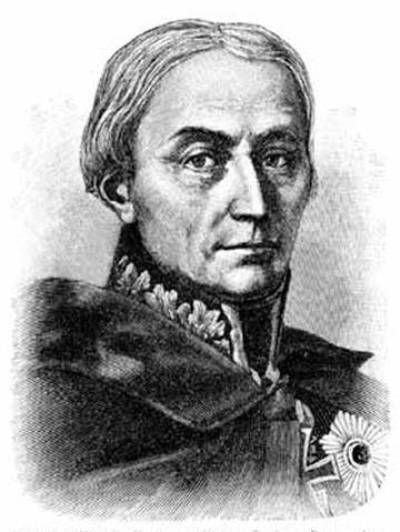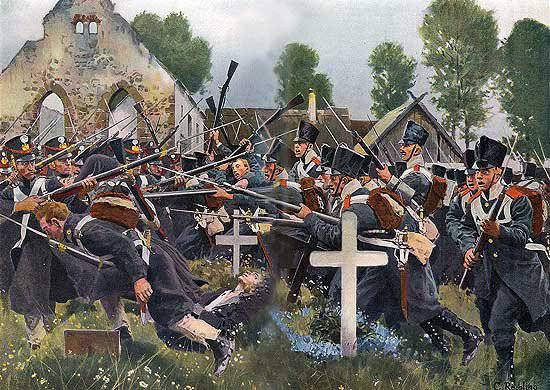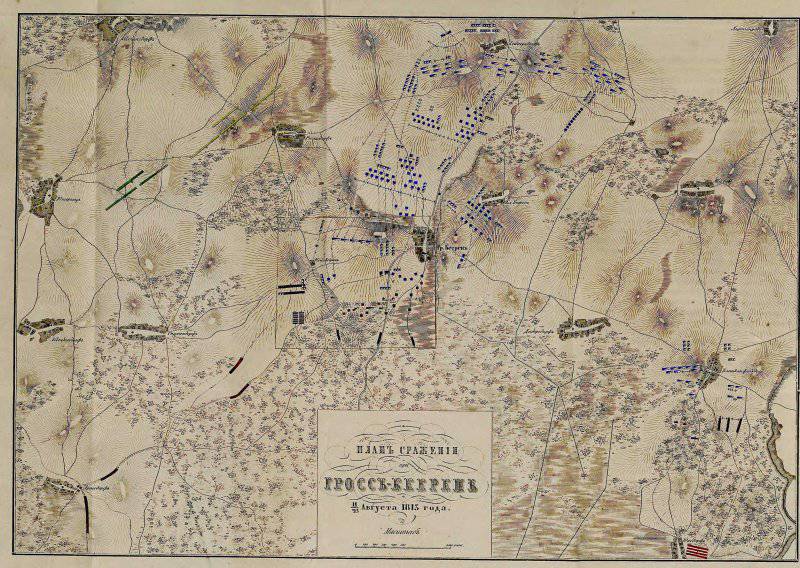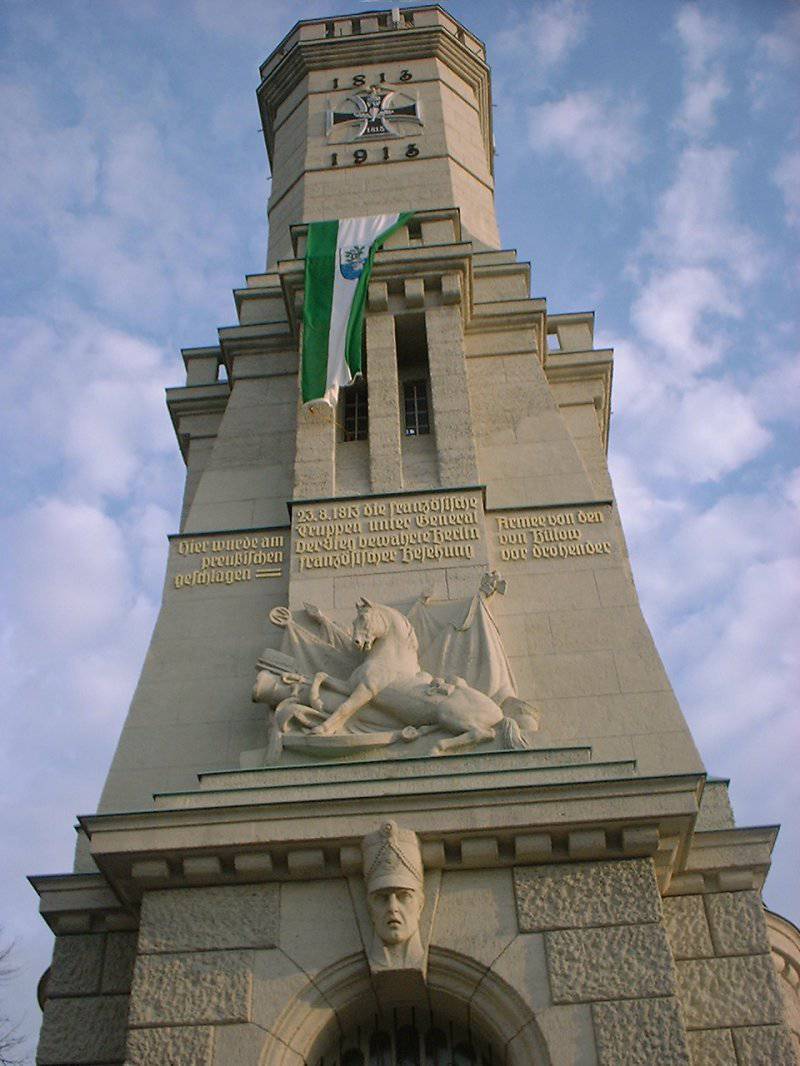The end of the 1813 truce of the year. Battle of Grosberen 23 August 1813 of the year. Part of 2
After the failure of the Prague talks and the announcement of the end of the truce, a moratorium on crossing the demarcation line and the start of hostilities was to be observed for six days. However, the Silesian army under the command of the Prussian General Blucher violated this condition. The Prussian general said it was time to end the political slapstick, and on August 14 1813 invaded the neutral territories around Breslau. He wanted to seize the harvest gathered by the peasants so that he would not go to the enemy.
The movement of the troops of Blucher was unexpected for the French command and distracted them from the Russian-Prussian columns under the command of Barclay de Tolly, who were moving to Bohemia to be connected with the Austrian troops under the command of Schwarzenberg. Blucher's determination led Napoleon to the idea that these were the main forces of the enemy, and he moved to the Silesian army. According to the Trachenberg plan, Blyukher, in whom a significant part of the troops consisted of landwehr (militia), immediately took back the troops on August 21. He retreated from the river Beaver to the river Katzbach, trying not to get involved in major battles. At this time, the Bohemian army, suddenly for the enemy, moved to Dresden through the Ore Mountains, threatening the rear of the main French army. Dresden was covered only by the corps of Marshal Saint-Cyr. Napoleon was forced to throw troops from Silesia back to his most important stronghold. Against Blucher left a strong barrier under the authority of MacDonald.
Simultaneously with the movement of the army of Napoleon, 70-thousand. army under the command of Marshal Oudin moved to Berlin. Udine had to support the French garrisons from Magdeburg and Hamburg. After the end of the truce, the French emperor was obsessed with the Prussian capital. He believed that after the capture of the Berlin by the French, Prussia would be forced to capitulate.
The ratio of forces in the Berlin direction
Under the command of Nicolas Charles Oudinot there were three corps. Divisional General Henri Gassien Bertrand (4 - 13 Thousands of Soldiers) commanded the 20 Corps, the unit was made up of Germans and Italians. 7 Corps was led by divisional general Jean-Louis-Ebenezer Rainier (20 - 27 thousand), it consisted of a French division and Saxon units. The 12 Corps was commanded by Oudino himself (20 - 24 thousand). The group also included cavalry under the command of Jean-Tom Arrigues de Casanoff (9 thousand) and artillery, which counted 216 guns. The total number of the group consisted of 70 thousand people (under the data of the Duke of Rovigo and A. I. Mikhailovsky-Danilevsky - 80 thousand soldiers). In addition, Oudinot was supposed to be supported by Marshal Davout from Hamburg (30 - 35 thousand French and Danes) and General J. B. Girard (10 - 12 thousand) from Magdeburg on the Elbe. It must be said that in the Udino group there were a lot of unexplained soldiers, recruits. Napoleon, after the crushing defeat of Prussia in 1806, was contemptuous of the Prussians. However, he did not take into account that the shame of the battle of Jena and Auerstedt mobilizes the Prussian army.
Udino was the most experienced commander who was not afraid of the enemy — he was wounded for the twentieth time under Berezina. In the battle at Berezina, he covered the waste of the remnants of the Great Army. In the battle of Bautsen, Napoleon entrusted to him the attack of the right wing of the allied army and the marshal led it with the persistence necessary for success. However, during the attack on Berlin, he did not show his usual determination. The heterogeneous composition of the troops caused him to doubt, there was no confidence and commanders. Rainier was offended that his peers got a marshal's baton and showed obstinacy, self-will. Bertrand was better known for his engineering knowledge than his military exploits.
Udino launched an attack on the Prussian capital, moving from Dame through Trebin and Mitenwalde. The troops of Davout and Girard could reach the rear of the Northern Army of Bernadot and cut off the routes of retreat to Berlin. According to Napoleon's plan, all three groups of troops were to unite into one army, capture Berlin, lift the siege of the Oder fortresses, defeat the Northern army and force Prussia to surrender.
The northern army under the command of the future King of Sweden and the former French commander Bernadotte was also motley in terms of national composition, as were the troops of Oudinot. It included Prussian, Russian, Swedish troops, small contingents of small German states and even an English detachment. The most powerful contingent was represented by the Prussians: two Prussian corps - the 3 corps under the command of Lieutenant-General Friedrich von Bülow (41 thousand soldiers with 102 guns), and the 4-corps under the command of Lieutenant General Boguslav Tauencine of graph von Wittenberg (39) man, xnumx guns). In addition, the Prussian corps were reinforced by Russian Cossack regiments. In the Russian corps under the command of Lieutenant-General Ferdinand Fedorovich Wintsinerode there were about 56 thousand people and 30 guns. The Swedish Corps under the command of K.L. Stedinga had 96 – 20 thousand people with 24 guns. The rest of the troops entered the consolidated corps under the command of Lieutenant General Ludwig von Valmoden-Gimborne (was in the Russian service). The consolidated corps was 62 Thousands of Soldiers with 22 guns. In total, under the leadership of Bernadot there were about 53 thousand people with 150 guns, but part of the forces were in separate detachments and garrisons scattered around Prussia. Therefore, the ratio of forces was approximately equal. The question was who would be able to concentrate more troops on the battlefield. In this, Bernadot had an advantage. The main forces of the Northern Army (369 thousand soldiers with 94 guns) defended the area of Berlin. In the center at Genersdorf there was the Bülov 272 Corps, on the left flank at Blankefeld - the Tauentsin von Wittenberg 3 Corps, at the right flank, at Rullsdorf and Gütergorts - the Swedish troops.
It should also be noted that Bernadotte enjoyed great prestige in the Allied forces. The commander-in-chief of the Northern army was valued as a former associate of Napoleon. It was believed that he was the author of a general plan of action for all the allied armies. However, despite the favor of public opinion, the position of the Swedish commander was very difficult. The northern army was not homogeneous, consisted of various national contingents. Bernadotte had to leave troops to defend Berlin, watch the enemy troops in Hamburg and Lübeck and the French garrisons in the rear of the Oder (in Stetina, Glogau and Kustrin), while conducting offensive actions, forcing the Elbe. In addition, the Swedish corps was inferior to the Prussian and Russian troops in combat experience, tactical ability and equipment. The Russian corps of Wintzingerode consisted of experienced soldiers with high morale. Byulov's corps, which had already won victories at Halle and Lukau, was distinguished by high combat capability. From the very beginning, a conflict arose between Bernadotte and Prussian commanders. The crown prince came into conflict with Bülow and irritated the Prussians with the fact that the coast was Swedish troops and preferred the Russian troops to the Prussian ones. As a result, Bülow and Taujentsin, commanding the troops covering Berlin, considered themselves in the right to act independently, which displeased the commander.
A dispute arose between Bernadot and the Prussian generals about the actions of the Northern army. 5 (17) August a military meeting was held, where the commander offered Bulow to present his vision for the upcoming campaign. Bülow, like other Prussian generals, proposed to move to Saxony, since the Brandenburg possessions were exhausted by standing troops. Swedish generals supported this view. However, Bernadot considered the attack dangerous.

Friedrich Wilhelm von Bülow (1755 - 1816).
Battle
Torrential rains blurred the roads, and Oudinot was forced to divide his group. All three corps went different roads. The 7 Corps (Saxon) and cavalry marched to Gross-Beeren in the center. On the left wing, the 12 body was moving to Ahrensdorf, on the right wing, the 4 body was moving to Blankenfeld. 10 (22) August 1813, the French corps came into contact with the Prussians, the Prussian corps, not taking the fight, moved north towards Berlin and took more advantageous positions. The 3 Corps of Bülow blocked the road to Berlin outside the village of Gross Beeren (in 18 km south of the center of the Prussian capital), and the 4 Corps of Tauenzin closed the road at the village of Blankenfeld. The Wintzingerode corps stood at Gütergoz, the Swedes at Rulnsdorf.
The appearance of the French army in one small transition from Berlin caused great apprehensions in Prussia. Bernadot gathered the commanders to the meeting. The commander of the Northern Army said that the battle must be given. The question is where? But he expressed his doubts about the success, speaking about the heterogeneity of the troops, a significant number of non-shot Prussian militia, the possibility of the appearance of the main enemy forces led by Napoleon. Bernadot originally wanted to withdraw the troops for the Spree and sacrifice Berlin. When Bülow expressed the general opinion of the Prussian generals that Berlin could not be ceded under any circumstances, the prince said: “What is Berlin? City! ”Bülow replied that the Prussians would rather all fall from weapons in their hands, rather than retreat for Berlin.
11 (23) August Udino attacked Prussian positions with 4 and 7 buildings. The 12 Corps did not participate in the battle, it covered the left flank. The French commander-in-chief expected that other enemy corps would appear from this side. Moreover, he believed that on this day there would be no decisive battle. The Prussian corps of Tauensin entered into a shootout with the enemy in 10 hours. In this battle at the village of Blankenfeld and limited. The corps of the Tauentsin from the regular troops had only the 5-th reserve regiment, the rest of the infantry and cavalry was made up of landwehr (militia). However, the nature of the terrain contributed to the defense of the corps: at Blankenfeld, the position of the corps was located between the swamp and the lake.
7 th corps Rainier acted more actively. The Saxons joined the battle in the 16 watch and immediately stormed the village of Gross-Beeren, knocking out the Prussian battalion from there. However, they did not move further, it began to rain heavily, the Saxons considered that the battle was over for that day. Rainier did not know that the Prussian hull was located less than two miles from it. In addition, the Saxon corps was in a strong position: on the left flank there should have been the 12 corps and the Arrigi cavalry, on the right - the swampy lowland and the moat.
Bülow did not believe that the battle was over. He knew that a whole enemy corps was attacking Tauenzin and decided to take advantage of the disunity of the enemy forces. Bülow wanted to crush the enemy center, forcing the flanks to retreat. He moved the 3 and 6 brigades of Prince L. of Hessen-Homburg and K. Kraft to Gross-Beeren, reinforcing their 4 brigade with G. Tyumen. At the same time, the brigade of L. Borstel moved around the right flank of the enemy. The troops met the news of the attack with joy.
Gross-Beeren 11 (23) August 1813 Battle Scheme
Having fired at the enemy camp, the Prussian troops launched a counteroffensive. For the Saxons, this attack came as a surprise. The first to break into the village was the Kraft brigade. But the Saxons repulsed the attack. With a repeated bayonet attack, the Prussian infantry drove the enemy out of Gross-Beeren. Many Saxons were exterminated by bayonets and butts, drowned. The Saxon Division Zara was overturned. Zar himself, trying to defend the artillery, rushed with two battalions towards the Prussian troops, but was defeated. He himself was nearly captured, received several wounds. The cavalry began to pursue the fleeing Saxons. The Saxon lancers tried to protect their infantry, but after several successful attacks, they were defeated by the Pomeranian cavalry regiment. Rainier tried to rectify the situation with the help of the French division Dyuryutta, which stood in the second line, but she was already involved in a general retreat. Later, the Saxons accused the French division of General PF of defeat. Dyuryutta, whose soldiers ran, not taking part in the battle, hiding in the woods. In addition, the Saxons expressed distrust of Oudinot, who was in no hurry to send the forces of the 12 corps to them. In 8 hours of the evening the battle was over. Rainier's hull was defeated and retreated.
The Saxon Corps was saved by General A. Guillemino’s infantry division and General F. Fournier’s cavalry division, sent out by Udino, from complete defeat. Bertrand, upon learning of Rainier's defeat, withdrew his troops from Blankenfeld. At this time in the evening on the left flank of the group Udino came the Russian and Swedish corps under the authority of Bernadotte. Oudin did not take the battle and led the troops. The Swedish crown prince was in no hurry to take advantage of the success of the Bülow corps and defeat the entire Udino group. 24 August troops rested, they made only the next day and moved in small transitions. Therefore, Udino withdrawn the troops without haste.
Victory Prussian corps caused a patriotic upsurge in Prussia. Berlin managed to defend. The townspeople were delighted with Bülow and the Prussian military. The morale of the Northern Army has increased greatly.

K. Rehling. Battle of Gross-Beeren 23 August 1813
Conclusion
Other French connections were unable to assist Oudinot. The Girard squad suffered 27 August defeat at Belzig from the Prussian landver and the Russian squad commanded by Chernyshev. The French lost 3,5 thousand people and 8 guns. Davou, having learned about the defeat of other forces, retreated to Hamburg, from where he no longer appeared.
The grouping of Udino in the battle of Grosberen lost 4 thousand people (2,2 thousand killed and wounded, 1,8 thousand prisoners) and 26 guns. The loss of Prussian troops amounted to about 2 thousand people. A significant amount of captured weapons were captured, they were thrown during the flight. This made it possible to improve the armament of parts of the Prussian landver. The main losses occurred in the Saxon part of the hull Rainier. This increased the irritation of Saxon officers, who had already thought about switching to the side of Napoleon’s opponents. In addition, Saxony was exhausted by the location of a huge French army during the armistice. Dissatisfaction with the Saxons by the French was manifested in the fact that almost all prisoners of Saxon origin, captured in the battle of Grosberen, went over to the side of the allied forces. The French, despite the courageous resistance of the Saxons in the battle of Grosberen, accused them of failing the offensive.
Napoleon was displeased with the actions of Oudinot. His particular irritation was caused by the fact that Oudinot took his troops to Vitenberg, and not to Torgau. As a result, his group was distant from the reserves in Dresden, the disunity of the French troops increased. Planning to strike again in Berlin, the French emperor replaced Oudinot with Marshal Ney and promised to strengthen his grouping.
Tower-memorial in honor of the victory of the Prussian troops at Grosberen in 1813.


Information